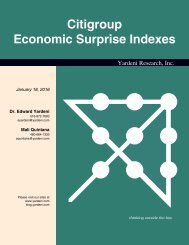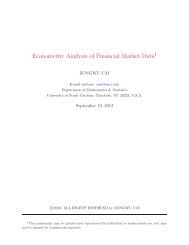Illiquid Asset Investing 1. Liquidating Harvard
Illiquid Asset Investing 1. Liquidating Harvard
Illiquid Asset Investing 1. Liquidating Harvard
You also want an ePaper? Increase the reach of your titles
YUMPU automatically turns print PDFs into web optimized ePapers that Google loves.
Andrew Ang <strong>Illiquid</strong> <strong>Asset</strong> <strong>Investing</strong> <strong>Asset</strong> Management<br />
considerably fewer properties than the thousands included in NCREIF, they face<br />
considerably more idiosyncratic risk. While this large amount of idiosyncratic risk can<br />
boost returns in some cases, it can also lead to the opposite result. Returns to illiquid asset<br />
investing can be far below a reported index.<br />
4. You cannot separate factor risk from manager skill<br />
Tradeable and cheap index funds in bond and stock markets allow investors to separate<br />
systematic returns (or factor returns, see Chapter XX) from management talent. In illiquid<br />
markets, no such separation is possible: investing in illiquid markets is always a bet on<br />
management talent. The agency issues in illiquid asset markets are first-order problems,<br />
and I discuss them in Part III of this book. Agency issues can, and often do, overwhelm<br />
any advantages that an illiquidity risk premium may bring.<br />
Taking into account data biases, the evidence for higher average returns as asset classes become<br />
more illiquid is decidedly mixed, as Ang, Goetzmann and Schaefer (2011) detail. 22 But while<br />
there do not seem to be significant illiquidity risk premiums across classes, there are large<br />
illiquidity risk premiums within asset classes.<br />
4.3 <strong>Illiquid</strong>ity Risk Premiums Within <strong>Asset</strong> Classes<br />
Within all the major asset classes, securities that are more illiquid have higher returns, on<br />
average, than their more liquid brethren.<br />
U.S. Treasuries<br />
A well-known liquidity phenomenon in the U.S. Treasury market is the on-the-run/off-the-run<br />
bond spread. Newly auctioned Treasuries (which are “on the run”) are more liquid and have<br />
22 Nevertheless, there are common components in illiquidity conditions across asset classes: when U.S. Treasury<br />
bond markets are illiquid, for example, many hedge funds tend to do poorly. See, for example, Hu, Pan and Wang<br />
(2012).<br />
22




